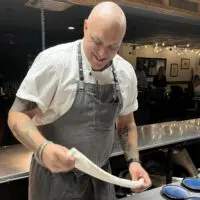Bardea Food + Drink is one of the restaurants trying a temporary surchange to help them beat inflation. Photo by Valeria Boltneva/Pexels
Since Valentine’s Day was on a Monday, many restaurants had four nights of solid reservations.
The business was welcome, considering that most experienced a disastrous January due to mask mandates, bitterly cold weather and ailing staff.
But a boost in reservations is not enough to sustain an industry hit hard by the pandemic, staffing shortages, supply chain issues and soaring overhead prices.
To put it simply: Restaurants are hurting.
Actual sales in 2022 are projected to remain below 2019 levels in all major segments, from quick-serve eateries to full-service restaurants, according to the National Restaurant Association’s “The State of the Restaurant Industry 2022.”
Nationwide, more than 90% of operators say food costs are higher than before COVID-19; eight in 10 report that labor costs are up. Both will continue to rise in 2022.
“We’ve seen huge price increases,” said Scott Stein, who with chef Antimo DiMeo owns Bardea Food & Drink in downtown Wilmington. “Everyone we order from is having shortages, and we are paying a premium — everything we order is handpicked.”
This week, Bardea added a 5% surcharge to checks to help cover rising costs. The popular eatery, featured on the “Today Show,” is not the only restaurant getting creative to make ends meet.
The next 12 months will be a “fragile” time for the industry, said Carrie Leishman, president and CEO of the Delaware Restaurant Association.
“You’re going to see a lot of different models out there,” she said.
A worldwide isssue
Price increases and supply chain issues affect most sectors, but unlike many industries, restaurants had a slim profit margin before COVID. On a good day, it was between 3% and 5%.
When restaurants were closed or limited to takeout, the Paycheck Protection Program kept Piccolina Toscana in Trolley Square and Brandywine Prime in Chadds Ford afloat, said owner Dan Butler.
“I was thrilled with it,” he said.
But after the economy reopened, employees were slow to return to the hospitality industry, and that’s led to wage increases.
At Snuff Mill Restaurant, Butchery & Wine Bar in Brandywine Hundred, employees who work at least 33 hours get health insurance, a gym membership and a monthly dinner out. And that’s just to start.
“We have to be very competitive against people like Amazon,” said Bill Irvin, an owner.
Similarly, Bardea gives full-time employees two weeks of paid vacation each year, healthcare benefits and a 401K.
The quick-service sector also has been impacted.
According to the Bureau of Labor Statistics, most fast-food chains raised wages by up to 10%.
The supply chain is another significant thorn in restaurants’ sides. Paying 50 cents extra per pound of beef puts a severe dent on the bottom line, said Irvin.
“It comes right out of our pocket; we’re absorbing those costs,” he said.
Increasingly, that is getting harder to do. As the supermarket shopper in your household will tell you, everything is going up.
According to the BLS data, pork jumped 14.1%, while beef prices rose by 20.1%.
“Sometimes, the cost of goods can go up in a couple of days,” said Matt Kern, owner of One Coastal in Fenwick Island.
A rising tide
Raising menu prices is one way to handle inflation.
According to the NRA’s report, eight in 10 full-service operators and two-thirds of limited-service operators adjusted menus due to food-and-beverage supply issues.
Many customers understand that the price of goods has gone up, said Ryan German, owner of Caffe Gelato in Newark. They are sympathetic to the increases of individual menu items as needed.
Depending on the concept, restaurants also could employ “shrinkflation,” the practice of offering less for the same price.
Or they can modify food-related promotions.
For instance, Maggio’s Little Italy, part of Brinker International, previously offered a two-for-one pasta deal. Then, in October, the restaurant began charging $5 for the additional entrée.
Chefs can also source more affordable ingredients. But that doesn’t sit well with Stein.
Bardea has a mission and reputation to uphold, he said. In 2019, the eatery received a semifinalist nomination in the James Beard Foundation’s “Best New Restaurant” category.
“What’s the use of doing what we’re doing if we need to bend on the quality?” he said.
But at the same time, will customers pay higher fees for the restaurant’s premium calamari?
Irvin agreed with Stein.
“There’s only so much you can charge before someone raises an eyebrow and says, ‘Well, geez, last week I paid $60, and now I’m paying $65?’”
The surcharge solution
Stein and DiMeo came up with a 5% surcharge to help offset crippling costs. It’s not a new approach.
Harley-Davidson added a materials surcharge to dealers, who are now passing those on to the customer, reports the Wall Street Journal.
“I applaud them; I think what Bardea is doing is important, and I want to see restaurants thrive again,” said Kern, a James Beard Foundation semifinalist.
This week, most customers didn’t bat an eye when they saw Bardea’s surcharge.
“They appreciate that we’re being transparent about it, and we’re not continuing to raise our prices,” Stein said.
Admittedly, it’s soon to truly evaluate the impact, he added.
Stein wishes the restaurant did not have to look for ways to cover higher costs.
“I’m doing this out of necessity,” he said. “Trust me; this is the last thing I’d ever want to do. We’re in a scary time right now.”
Others are watching Bardea’s approach with interest.
“We are considering it,” Irvin said. “It would really help out the restaurant and the employees, so we can support them in the best way.”
When Irvin was visiting his parents in Myrtle Beach, South Carolina, he noticed a surcharge on the restaurant check.
The operator gave the table the option of declining to pay it. Irvin happily anted up.
As he put it, “This is a time to sink or swim in this industry, and every little bit helps.”


Share this Post








